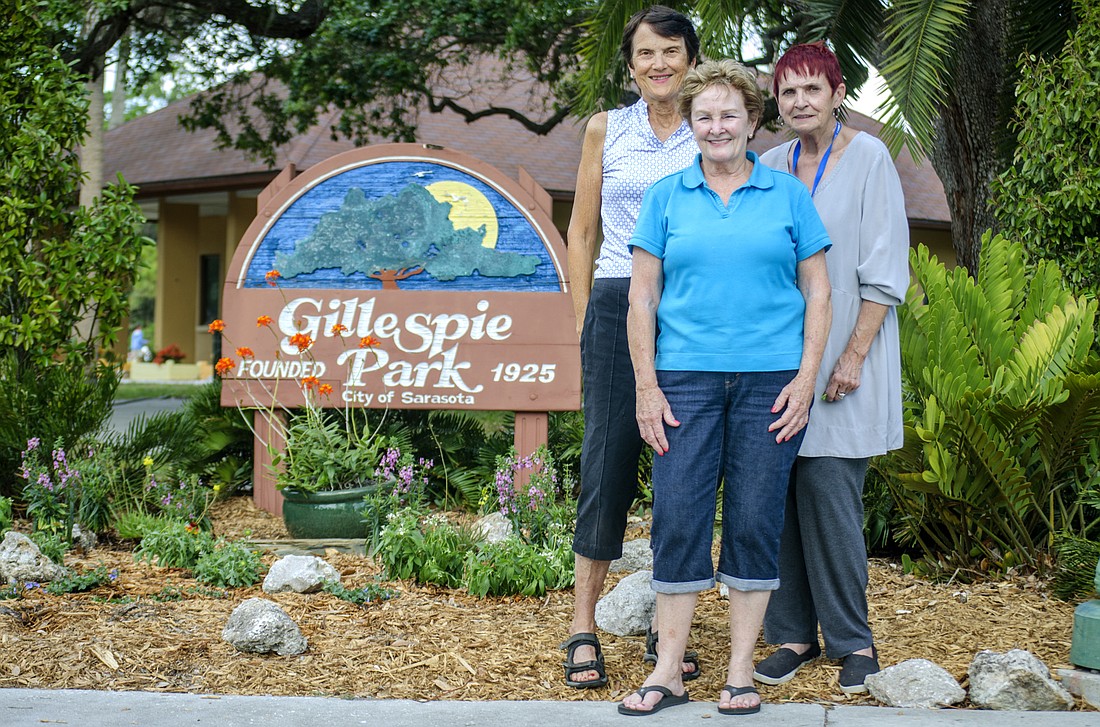- April 23, 2024
-
-
Loading

Loading

It’s a 10-acre park north of Fruitville Road. It has all the amenities one would expect in a city park — playground, walking paths, park benches.
But from the perspective of Linda Holland, Julie Feeley and Linda Jacob, Gillespie Park is more than just a green rectangle on a map. It’s more like a puzzle of individual, community-driven projects combining to make the whole.
The walking paths were poured during Sarasota’s park initiative in the mid-1990s. The playground is the product of a 2014 partnership with the Selby Foundation to replace old equipment.
The colorful benches aren’t just eclectic park fixtures. They’re the result of a 2013 partnership with Sarasota School of Arts and Sciences. Students submitted original murals, and the winners were painted on repurposed benches.
“Someone in the neighborhood had an idea that if we cleaned up the benches and sanded them or whatever, we could restore the ones that we had instead of asking the city to buy new ones,” Holland said.
The project, like many that followed, exemplifies the spirit of the neighborhood. It’s scrappy, resourceful and undaunted by such dirty jobs as raking leaves and planting flowers.
“People are coming in with fresh ideas, with a fresh perspective of the neighborhood,” Holland said. “(People are) seeing the potential … and knowing that with some work and some fun, we can do it.”
Holland keeps a scrapbook of all its projects in the Gillespie Park Police Substation, located at the southwest corner of the park. Photos of clean-up days and beautification projects all tucked in plastic sleeves and snapped into binders remind the trio and the rest of the neighborhood how far they’ve come.
“The association started in 1983,” Holland said. “So we have gone through a lot of major kind of things. The first push in the ’80s and in the ’90s, and the reason for the substation was the safety issue. That was the major thing, plus the park had never been upgraded.”
“(People are) seeing the potential … and knowing that with some work and some fun, we can do it.” - Linda Holland
Holland has lived in the neighborhood for 35 years. She remembers when the neighborhood’s energies were focused on dealing with perfunctory safety issues.
“I think the neighborhood, even from years back, has always been wanting the park to be utilized by families and children,” Holland said. “In the early years it wasn’t safe for anybody ... So that’s why we had to address the crime and safety issue for so many years.”
Trash, drugs and nefarious elements made the park unpleasant.
But with the bench project, and the addition of Feeley and Jacob to the neighborhood, its energies seemed to shift. Holland said most of the crime and safety issues have largely resolved themselves. There is a police presence in the park, and the park’s homeless population is respectful of the space.
Now the trio have a new impetus for improvements.
Beginning with the park benches and continuing with the playground equipment, the neighborhood’s focus has been making the park a place for children. In 2014, Jacob, Feeley and Holland spearheaded the neighborhood’s Reading Room.
It’s a small room in the park’s substation that welcomes neighborhood children two afternoons a week during the school year and an additional morning during the summer. They do crafts and work on homework, all under the watchful eye of Jacob and Feeley.
“This is a safe place for these kids,” Holland said. “They know they can come here.”
But their efforts aren’t just intended to make the children feel safe. It’s to make them feel invested in the park. Above all else Feeley, Jacob and Holland want Gillespie Park’s children to have a sense of ownership.
“I just think that if we are a community of activists, we all get an investment in our neighborhood, but then the greater city as a whole,” Feeley said. “We all, as adults, are giving back. We want to teach the children to give back to their community.”
The trio’s most recent endeavor is to create a butterfly garden around the park’s pavilion, near the Reading Room. With flowers and bushes, the garden will support butterflies throughout their life cycle.
It’s the group’s most ambitious project yet and will cost about $5,000. Jacob said the neighborhood hopes to pay for the project by leveraging grants from Sarasota County.
Jacob and Feeley have become well-practiced at writing grants. Many of the park’s projects have been funded with grant money. The grants require some sort of matching component, whether that be cash or volunteer hours.
And in a neighborhood that epitomizes a spirit of resourcefulness, Jacob almost always opts for volunteer hours. She turns in a spreadsheet to city or county officials, calculating from whom and when the hours will come.
The neighborhood’s younger residents are always included in her calculations.
“Helping with the projects here is a valuable lesson for them,” Feeley said. “It’s a two-way street in a neighborhood. If you want something to be special and interesting and valuable, it can help if you are one of the contributors to it.”
As the trio continue their stewardship over Gillespie Park, their projects will likely get bigger, taking every opportunity to make their park better. But their motivation will remain the same.
“We just want them to continue, not only as kids, but as they emerge into their adult lives to just thoroughly enjoy this park and know that they had a part in the development of it,” Feeley said.